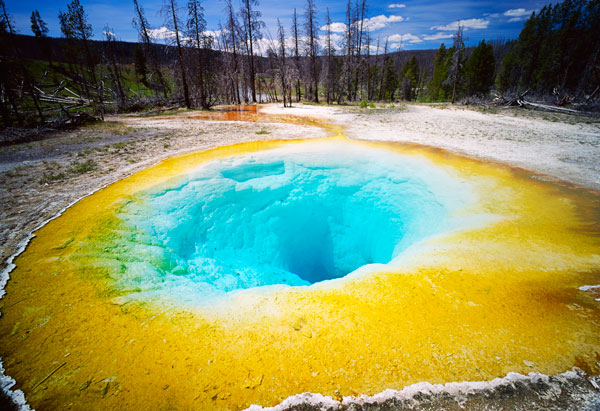10 Marvels of Our World

Photo: Jeff Foott/Getty Images
PAGE 2
Morning Glory Pool
In Yellowstone National Park, there is a hot spring (pictured above) that's alive (literally!) with electric hues. Named for its likeness to the azure, funnel-shaped morning glory flower, the pool gets its color from the bright blue bacteria that thrive in its scalding temperatures. The water averages 171.6 degrees, but it used to be even hotter—closer to 200 degrees—and bluer. Early visitors to the park tossed in coins and other objects, clogging the spring's geothermal source and allowing other, cooler-temperature yellow and orange microbes to spread further and further into its 23-foot depth. But there is hope the spring will one day return to its sapphire splendor: Back in 1950 it erupted like a geyser, ejecting, among other debris, $86.27 in pennies and 76 handkerchiefs. A few more purges like that one just might do the trick. —Jessica Silvester
Tsingy de Bemaraha
Some 200 million years ago on the island of Madagascar, a plateau of pure limestone lay in wait. Then water had its way: Erosion erased stone, leaving behind a forest of mineral spires—or tsingy, which translates "where one cannot walk barefoot." Imagine a fortress of razor-sharp pinnacles that shave the sky, and ghost-white lemurs leaping from column to column. Down below, deep canyons unravel in an ethereal labyrinth. —Kristy Davis
The Ochtinsk Cave
In this Slovakian cave, delicate white crystals grow along the walls like creeping wildflowers. The spectacular displays—branching tree formations, spirals, and coral patterns—won the site a spot on the UNESCO World Heritage list. —Arianna Davis
Next: Hundred-pound rocks that move all by themselves
In Yellowstone National Park, there is a hot spring (pictured above) that's alive (literally!) with electric hues. Named for its likeness to the azure, funnel-shaped morning glory flower, the pool gets its color from the bright blue bacteria that thrive in its scalding temperatures. The water averages 171.6 degrees, but it used to be even hotter—closer to 200 degrees—and bluer. Early visitors to the park tossed in coins and other objects, clogging the spring's geothermal source and allowing other, cooler-temperature yellow and orange microbes to spread further and further into its 23-foot depth. But there is hope the spring will one day return to its sapphire splendor: Back in 1950 it erupted like a geyser, ejecting, among other debris, $86.27 in pennies and 76 handkerchiefs. A few more purges like that one just might do the trick. —Jessica Silvester
Tsingy de Bemaraha
Some 200 million years ago on the island of Madagascar, a plateau of pure limestone lay in wait. Then water had its way: Erosion erased stone, leaving behind a forest of mineral spires—or tsingy, which translates "where one cannot walk barefoot." Imagine a fortress of razor-sharp pinnacles that shave the sky, and ghost-white lemurs leaping from column to column. Down below, deep canyons unravel in an ethereal labyrinth. —Kristy Davis
The Ochtinsk Cave
In this Slovakian cave, delicate white crystals grow along the walls like creeping wildflowers. The spectacular displays—branching tree formations, spirals, and coral patterns—won the site a spot on the UNESCO World Heritage list. —Arianna Davis
Next: Hundred-pound rocks that move all by themselves



